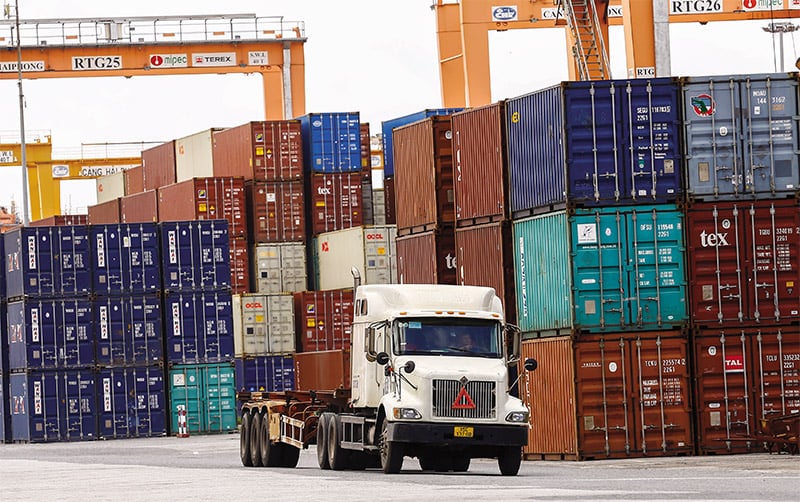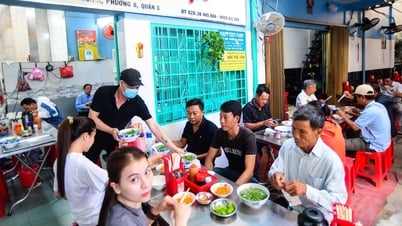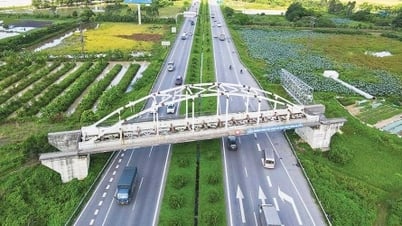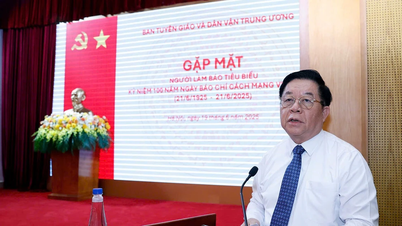The Vietnamese government is well positioned to manage uncertainties through a strong diversification strategy, expanding trade relations, enhancing regional connectivity, and deepening supply chain links beyond traditional markets.
Although businesses may experience a slowdown in growth in the short term, Vietnam’s logistics industry needs to step up efforts to improve efficiency and resilience, especially through stronger collaboration between public agencies and private enterprises, to maintain and strengthen the country’s regional leadership position.
 |
| With the open-door and integration policy, our country's logistics industry has many opportunities to accelerate development. Photo: Duc Thanh |
Benefits of pursuing an open trade policy
Vietnam has demonstrated a strong commitment to improving its commercial infrastructure, investing around 6% of GDP annually, well above the regional average. This investment has yielded significant results. For example, the Mekong Delta region has seen a significant transformation, attracting foreign investment through improved transport systems.
Vietnam operates 44 seaports with a total handling capacity of about 500 million tons/year, along with 22 airports, including 12 international airports. Major seaports and airports play an important role in facilitating trade.
However, logistics operations still rely heavily on road transport, which carries about 75% of freight and 90% of passengers. Over-reliance on roads, coupled with underdeveloped rail and waterway networks, creates inefficiencies, increases costs and reduces competitiveness.
To address these issues, on January 16, 2025, the Prime Minister issued Decision No. 140/QD-TTg approving the Detailed Planning of seaports, ports, wharves, buoys, water areas, and water regions for the 2021-2030 period, with a vision to 2050.
This plan aims to modernize seaport infrastructure, expand deep-water ports - inland ports, improve multimodal transport connections, with the goal of increasing port capacity to 1.25 - 1.5 billion tons/year by 2030.
Vietnam has also been actively pursuing an open trade policy. Notably, Vietnam is a member of both the ASEAN-China Free Trade Area (ACFTA) and the Regional Comprehensive Economic Partnership (RCEP). According to a 2022 report assessing the potential impact of RCEP, the World Bank (WB) said that Vietnam, along with other middle-income countries, could benefit the most from the agreement.
During the RCEP implementation period from now until 2035, the average tariff applied by Vietnam will decrease from 0.8% to 0.2%, while the tariff with Vietnam will decrease from 0.6% to 0.1%.
Four scenarios were simulated to assess the impact of RCEP implementation.
The first scenario simulates scheduled tariff reductions among members, as outlined in the agreement.
The second scenario adds the reduction of non-tariff barriers.
The third scenario incorporates reduced trade costs from a more liberal rules of origin regime.
The fourth scenario reflects productivity improvements associated with trade liberalization, often referred to as the “productivity push,” reflecting efficiency gains from lower trade costs.
All impacts are measured as a percentage change from the baseline for the 2014-2035 period. In the most optimistic scenario, RCEP could increase Vietnam’s income by 4.9%, the highest among all member countries. Vietnam is also expected to see an 11.4% increase in exports and a 9.2% increase in imports, highlighting its growing importance in regional trade flows.
Structural and environmental challenges
Many major manufacturers have shifted some production to Vietnam, helping to cement the country’s reputation as an emerging global manufacturing hub. However, the US tariff hike could create new uncertainties, raising concerns about Vietnam’s continued competitiveness as a key player in the global supply chain.
Despite its strong growth momentum and growing regional importance, Vietnam's logistics industry still faces a number of structural and environmental challenges.
 Despite its strong growth momentum and growing regional importance, Vietnam's logistics industry still faces a number of structural and environmental challenges.
Despite its strong growth momentum and growing regional importance, Vietnam's logistics industry still faces a number of structural and environmental challenges. 
While major cities in Vietnam have benefited from strong infrastructure investments, logistics performance in non-urban areas remains hampered by a number of structural challenges.
The patchy and inadequate road network in rural and remote areas contributes to congestion and frequent delivery delays. Many port systems are outdated and lack modern handling equipment, leading to shipping delays and high operating costs.
Although Vietnam has an extensive river network, both inland waterways and railways are still underutilized, resulting in an increasingly heavy dependence on road transport.
In addition, the lack of multimodal integration and seamless connectivity between road, rail and port systems is increasingly limiting the efficiency of the logistics chain and undermining the development of integrated end-to-end transport solutions.
Vietnam’s competitive advantages, including its strategic location, trade policy environment, developed infrastructure, and low-cost labor, have made it one of the biggest beneficiaries of the “China+1” strategy. However, Vietnam’s future role in the global supply chain remains vulnerable to geopolitical volatility and tariff policies, which pose a challenge to the country’s manufacturing and logistics competitiveness.
Source: https://baodautu.vn/vai-tro-cua-viet-nam-trong-chuoi-logistics-toan-cau-d301693.html




































































































Comment (0)